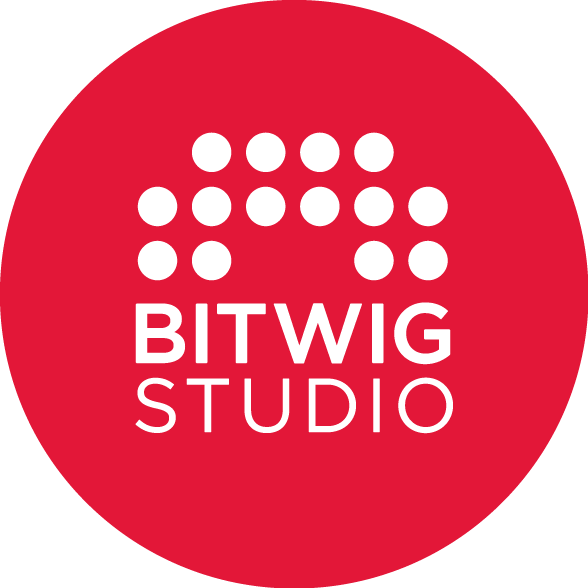✔ Clip Gain ✓ Clip Fades ✔ Comping ✔ Audio stretch quality ✔ Time stretching workflow Video track Ears-only mode Step recording Marker ranges ✔ Time signature automation Linked clips Revert bounces to MIDI ✔ Spectrum device Noise removal device ✓ Piano roll improvements LUFS Metering Default track devices Rewire device External audio editor Export Metadata Surround mixing Onset threshold Pitch correction Record macros Clip-based effects Always-on MIDI recording ✔ Convolution device ✔ Track status indicators Ripple Editing Directly Edit Waveforms In-Place MIDI Editing Clip Stamping Bounce Modulation
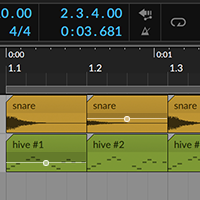 ✔ Implemented (3.3)
✔ Implemented (3.3)
Clip Gain
Quick arranger handles for in-place adjustments
Easily and quickly adjust the gain of clips right in the arranger with handy envelope handles. The adjustments match the gain settings in the inspector. As an exclusive DAW first, Bitwig allows clip gain for MIDI events as well, which multiplies the velocity of the notes in the clip.
[ back to top ]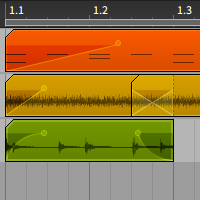 ✓ Partially Implemented (2.0)
✓ Partially Implemented (2.0)
Clip Fades
Multiplicative crossfades that work on anything - even MIDI clips
Arranger clips can overlap each other, with the option for automatic and editable crossfades to appear. You can also easily drag in fade handles from clip edges to quickly create fades in and out. As a DAW first - Bitwig can handle fades on MIDI clips as well. Bitwig will intelligently detect the last instrument in the chain and apply fades to its output, leaving downstream devices to produce FX tails. As another innovation - clip fades can be assigned to parameters other than just gain, as well.
[ back to top ]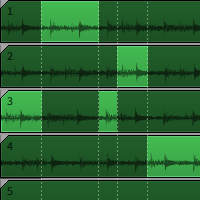 ✔ Implemented (4.0)
✔ Implemented (4.0)
Comping
Record multiple takes and choose the best parts
With loop-recording enabled, each pass will record a take into a separate lane in the same track. You can expand the lanes to view all the takes, and easily audition them. With all the takes visible, simply add a vertical slice anywhere and choose the best part in each column to produce your final composite. Adjust crossfade amounts, then leave it as is and collapse the lanes, or bounce the result in place.
[ back to top ]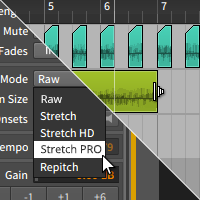 ✔ Implemented (2.3)
✔ Implemented (2.3)
Audio stretch quality
Too much grain makes for an unhealthy diet
Stretch PRO is an incredibly smooth and artifact-free time stretching algorithm. This produces very natural results even with extreme values.
[ back to top ] ✔ Implemented (3.3)
✔ Implemented (3.3)
Time stretching workflow
Stretch anything, anywhere
You can now stretch clips freely in the arranger by dragging their edges with a modifier key - including MIDI clips, which will scale internal notes proportionally. If you're a sound designer or editor, you'll love the hands-on freedom and experimentation this allows you, be it creative or to quickly sync to other sources.
[ back to top ]
Video track
An ultra-smooth scoring to picture workflow
Import and sync your arranger timeline with many common video formats for frame-perfect scoring or sound design to picture. The video can be displayed docked in the new video panel, or in a floating window on any monitor. With Bitwig Studio's unparallelled workflow and device flexibility, the possibilities are endless.
[ back to top ]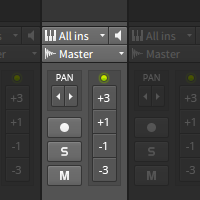
Ears-only mode
Hides all values and visual indicators for ears-only mixing
All meters are disabled across the UI, only showing an indicator that audio is playing. Channel faders and panning knobs are replaced by increment and decrement buttons, hiding current values. All plugins hide their visual cues and values, such as compressor gain reduction. Spend some time mixing blind, trust your ears, then turn it off and be surprised by your own results.
[ back to top ]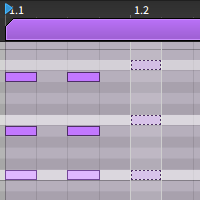
Step recording
Record your ideas at your own pace
Easily input melodies, chords, and quick corrections by holding down the keys on your MIDI controller and pressing the arrows on the computer keyboard for the desired length. Alternatively, you can enter continuous step-input mode, where each MIDI key press will draw a note quantized to the current grid settings, and move the playhead ready for the next note.
[ back to top ]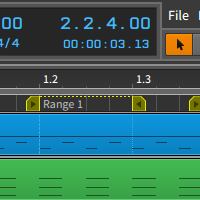
Marker ranges
Save timeline regions for easy selection and batch-export
Define ranges that correspond to sections of your arrangement, and use them to quickly make selections, shuffle entire arrangement vertical slices around, and for batch file-exporting.
[ back to top ]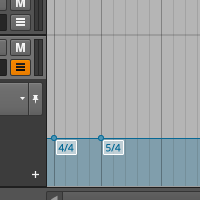 ✔ Implemented (2.3)
✔ Implemented (2.3)
Time signature automation
Not all music is meant for the dance floor
Bitwig Studio continues its tradition of keeping things clear and readable with ultra-simple time-signature automation, available in the transport section of the master track automation lanes. Simply add a new node, enter the new time signature, and the arrangement grid adjusts accordingly.
[ back to top ]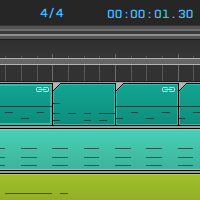
Linked clips
Edit a master clip and they all magically change
Easily create as many linked copies of a clip as you'd like, and edits will be mirrored across all of them. You can link both audio and MIDI clips, and all edits will be observed, such as note placement, audio event cuts, gain changes, automation, etc.
[ back to top ]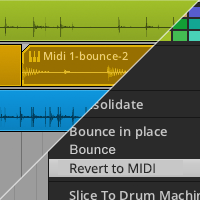
Revert bounces to MIDI
Bitwig remembers your original MIDI notes when bouncing
You don't have to keep a reference MIDI track around when bouncing audio. This keeps your session visually organized and clutter-free. Bitwig will remember the original MIDI data for bounced audio clips, allowing you to go back and make tweaks before bouncing again.
[ back to top ] ✔ Implemented (2.0)
✔ Implemented (2.0)
Spectrum device
Detailed, layered analysis of your frequency content
A new spectrum device shows you your frequency content in real-time, anywhere in the signal chain. You can configure the refresh rate and averaging values for easy readability and CPU usage. To top it off, the EQ-5 device has a toggle to show the spectrum overlayed with the equalizer nodes.
[ back to top ]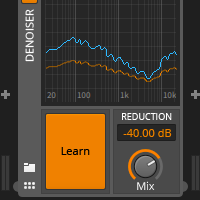
Noise removal device
Easily profile your noise floor and cleanup your audio
It doesn't get any easier than this. Simply press the 'Learn' button, playback a quiet section of your audio to capture the noise floor, then turn off the 'Learn' button. The Denoiser will subtract the noise floor from the audio while preserving detail, with adjustable amounts.
[ back to top ]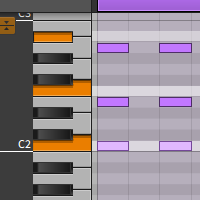 ✓ Partially Implemented (2.4)
✓ Partially Implemented (2.4)
Piano roll improvements
Active note highlights, octave duplication, parameter ramps, selection scaling
Enjoy tons of improvements and handy tools in the piano roll, including better highlighting of active MIDI notes, keyboard shortcuts for octave-duplication of notes, quick linear and bezier ramps of any parameter including velocity, and proportional scaling of a selected region of notes.
[ back to top ]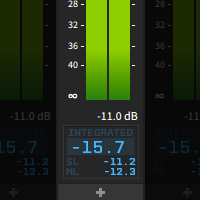
LUFS Metering
The loudness war is over
For broadcast professionals and mixers looking to preserve dynamics over crushed peaks, Bitwig Studio integrates LUFS metering. This conforms to the European Broadcast Union of measuring loudness (ITU-R BS.1770-2), and gives you a real-time overview of your short-term, momentary, and integrated loudness values, which can be more valuable than peak and RMS metering alone.
[ back to top ]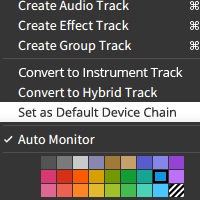
Default track devices
The most flexible channel strips in the world
You can now create your own 'channel strips' composed of any number of native devices and plugins. Simply design your chain on any track, then designate that track as the default chain to be applied to all newly-created tracks.
[ back to top ]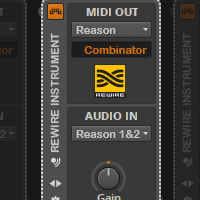
Rewire device
You'd rather get to work than configure loopback devices
Easily communicate with other Rewire enabled programs via the new Rewire device. Gone are the days of configuring audio and MIDI loopback devices, complex connections, and restoring values from session to session. Rewire is battle-tested with zero-configuration, so you can stay in a creative headspace while producing.
[ back to top ]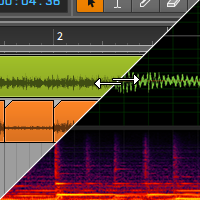
External audio editor
Two peas in an audio pod
Specify your destructive audio editor of choice, and easily edit any audio clip from the arranger or inspector. After saving your changes and returning to Bitwig Studio, your audio is updated instantly for a quick turnaround workflow.
[ back to top ]
Export Metadata
Project information can be embedded as BWF and ID3 metadata on export
Bitwig Studio already incorporates a handy panel to specify information about your project, and now you can include this as Broadcast Wave Form and ID3 metadata when rendering.
[ back to top ]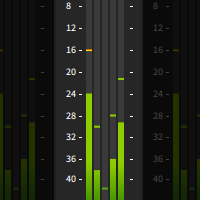
Surround mixing
Because stereo is so 1968
Define any number of output channels for your project, and all new mixing tools reflect this across the entire UI. Easily mix with the new Surround Panner device, and export your session as a singular multi-channel wave file, or individual discrete channels. Tracks are no longer limited to stereo, and support any number of inputs and multi-channel audio files.
[ back to top ]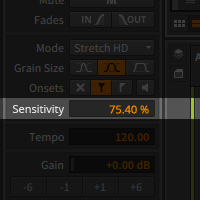
Onset threshold
Easily adjust the sensitivity of onset detection
Adjusting onsets is already easy, but now you can fine-tune Bitwig Studio's automatic transient detection. Simply adjust the sensitivity value and watch the onsets shift in real-time to find the closest match to your source material.
[ back to top ]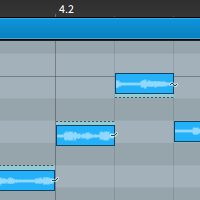
Pitch correction
Tune your audio, from natural to robotic
An integrated pitch editor lets you visually tune your audio using the familiar piano roll. See how far the detected pitches are from notes, and adjust them accordingly. You can also adjust the formants, vibrato, and natural slides leading into and out of discrete pitches. This can produce anything from subtle adjustments to drastically flat and robotic effects. Bitwig Studio's innovative histograms let you edit multiple values at once in useful and creative ways.
[ back to top ]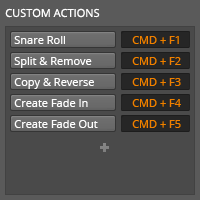
Record macros
Save time with global and project-specific macros
You can record any number of sequential actions into singular macros. These macros offer quick, one-click access to repetitive tasks, and can be assigned keyboard shortcuts to dramatically speed up your workflow. Macros can either be global, or project-specific.
[ back to top ]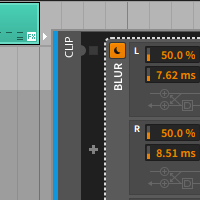
Clip-based effects
Apply any effects to individual clips and avoid messy envelopes
You can now apply any number of effect devices to individual clips, which are separate from its containing track effects. Instead of complicated automation for different arrangement sections, easily add one-off effects to specific parts.
[ back to top ]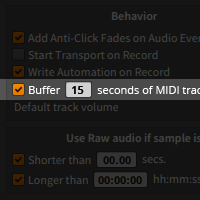
Always-on MIDI recording
Performed the perfect take without recording? No problem.
Bitwig Studio can constantly buffer the input of any armed MIDI tracks, even if recording is not currently taking place. Like what you just played? Simply double click to create a new MIDI clip, and it will contain your last played notes instead of being empty.
[ back to top ]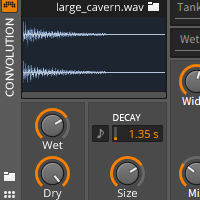 ✔ Implemented (4.3)
✔ Implemented (4.3)
Convolution device
CPU-efficient, multi-channel convolution for breathtaking spaces
Compact and powerful, the Convolution device lets you load any standard wave files for ultra-realistic reverbs and exotic sound design. Supporting both mono and multi-channel source material, the device is CPU-efficient and excellent on return channels.
[ back to top ]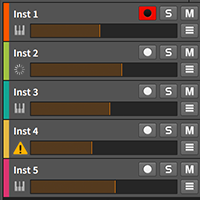 ✔ Implemented (3.0)
✔ Implemented (3.0)
Track status indicators
At-a-glance track indicators for quick troubleshooting
Tracks have status indicators whenever they are not ready. For example, tracks with plugins still loading will show a spinner, and tracks with missing plugins will show a warning icon.
[ back to top ]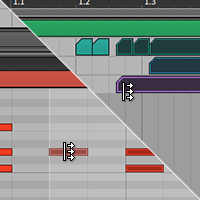
Ripple Editing
Fast workflow shortcuts for moving downstream items
With a quick keyboard hotkey or UI toggle, you can move a clip and have all downstream clips move as well, leaving items earlier in time untouched. You can restrict this to the current track or all tracks, and it even works with MIDI notes as well.
[ back to top ]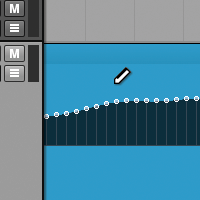
Directly Edit Waveforms
Draw your sound!
Now in Bitwig Studio, you can zoom in to the sample level on any audio clip - whether in the arranger or edit views - and manually edit the samples with the pencil tool. You can easily eliminate zero-crossing clicks and pops, or create entirely new sounds!
[ back to top ]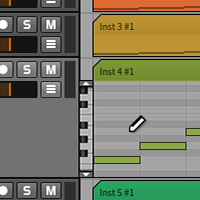
In-Place MIDI Editing
Edit Midi Clips directly inside the arranger
You can now create and edit MIDI data without leaving the arranger. Simply double-click a clip or use a keyboard shortcut to temporarily expand it with full editing capabilities, including velocity, timbre, and other performance data. Click anywhere else to collapse the view.
[ back to top ]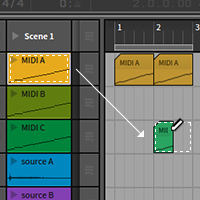
Clip Stamping
Select a source clip and draw it anywhere
You can add multiple audio or MIDI clip copies at once for a fast workflow boost. Simply select any source clip and the pencil tool, hold the keyboard modifier, and 'draw' in copies of the source anywhere in your arrangement. Rinse and repeat.
[ back to top ]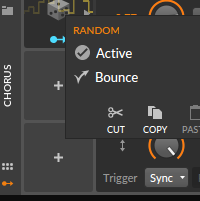
Bounce Modulation
Render modulators to an automation lane and note velocity
Bitwig Studio's advanced Unified Modulation System is now more powerful than ever! With a simple right click on any modulator you can bounce the modulation to a new automation lane. Perfect for final tweaking of that filter sweep or freezing that random modulator. Modulators that are inside a Note Velocity device are bounced directly to note velocity, rather than an automation lane.
[ back to top ]